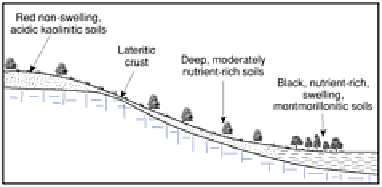Environmental Engineering Reference
In-Depth Information
Figure 27.5
Catena sequence in a savanna area.
are very abundant, and their mounds are a major feature of the savanna landscape (Plate
27.7). These insects attack and macerate plant debris, making it more readily available for
decomposition by other organisms. They also eat growing plants, especially during
periods of drought. As a result of these activities, methane is released to add to the
increase in greenhouse gases in the atmosphere. Although the calculations are imprecise,
the contribution from termites is believed to be about 8 per cent of the global production
of methane.
ENVIRONMENTAL PROBLEMS OF DRY LANDS
WATER RESOURCES
The dry lands of the world present many problems of development, most stemming from
the constraints determined by a climate with a lack of water. Depending upon the degree
of aridity, water may be available from:
1 Perennial rivers whose headwaters are in wetter areas, such as the Nile, the Niger or the
Tigris.





